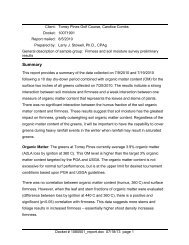is bulk density the answer? - PACE Turf
is bulk density the answer? - PACE Turf
is bulk density the answer? - PACE Turf
Create successful ePaper yourself
Turn your PDF publications into a flip-book with our unique Google optimized e-Paper software.
<strong>PACE</strong> INSIGHTS January, 2001 Volume 7 Number 1 page 2<br />
right management programs. And it <strong>is</strong> for th<strong>is</strong> reason<br />
that it’s so important to confirm <strong>the</strong> accuracy of any<br />
measurement that <strong>is</strong> used to estimate compaction.<br />
Plant need<br />
for loose soil =<br />
LOW COMPACTION<br />
Area of overlap<br />
Golfer need for<br />
compacted soil =<br />
HIGH COMPACTION<br />
Bulk <strong>density</strong>: a definition<br />
Bulk <strong>density</strong> <strong>is</strong> a measurement of soil weight that takes<br />
two components into account: <strong>the</strong> particle weight<br />
(weight of soil solids such as sand, silt, clay and<br />
organic matter), as well as <strong>the</strong> air trapped in <strong>the</strong> soil’s<br />
pore spaces.<br />
Bulk <strong>density</strong> measurements are usually expressed in<br />
grams per cubic centimeter (g/cc) which reflects <strong>the</strong><br />
fact that we are measuring <strong>the</strong> weight (in grams) of a<br />
given volume of soil (in cubic centimeters). Soil <strong>bulk</strong><br />
<strong>density</strong> measurements fall into a relatively narrow<br />
range – usually between 1.0 and 2.0. g/cc.<br />
Bulk <strong>density</strong> and compaction: are <strong>the</strong>y related?<br />
The <strong>answer</strong> to <strong>the</strong> question above <strong>is</strong> “Yes”. And also<br />
“No”. And sometimes, “It depends.” Here’s why it’s<br />
hard to get a straight <strong>answer</strong>.<br />
In <strong>the</strong> world of turf management, <strong>bulk</strong> densities are<br />
frequently used to determine soil compaction levels.<br />
The assumption <strong>is</strong> that because <strong>the</strong> total volume of air<br />
filled pores <strong>is</strong> included in its calculation, <strong>bulk</strong> <strong>density</strong><br />
should provide a good estimate of soil compaction.<br />
Compacted soils with few air filled pores have high<br />
<strong>bulk</strong> densities, whereas looser, more porous soils have<br />
more air filled pores, and <strong>the</strong>refore have lower <strong>bulk</strong><br />
densities. As <strong>bulk</strong> <strong>density</strong> increases, it should become<br />
more difficult for roots to penetrate and grow through<br />
<strong>the</strong> soil. In addition, air, gas and water movement<br />
should also be significantly slowed down. Some<br />
typical <strong>bulk</strong> densities are l<strong>is</strong>ted in Table 1.<br />
So far, so good. But <strong>the</strong> reality <strong>is</strong> that <strong>bulk</strong> <strong>density</strong><br />
measurements taken on golf courses have been<br />
incons<strong>is</strong>tent and typically do not accurately represent<br />
<strong>the</strong> level of compaction present. And when <strong>the</strong> USGA<br />
evaluated <strong>the</strong> use of <strong>bulk</strong> <strong>density</strong> measurements as a<br />
tool for selecting root zone mixes, <strong>the</strong>y decided that <strong>the</strong><br />
measurement wasn’t useful in predicting performance<br />
(Hummel, 1993) and as a result dropped <strong>bulk</strong> <strong>density</strong><br />
as a parameter for accepting or rejecting root zone<br />
mixes. There are several reasons why <strong>bulk</strong> densities<br />
don’t necessarily reflect reality when it comes to golf<br />
course greens, as described below.<br />
Not all pores are alike<br />
Just to review, <strong>bulk</strong> <strong>density</strong> measures <strong>the</strong> weight of soil<br />
particles PLUS any air trapped between particles in<br />
spaces known as pores. High <strong>bulk</strong> densities are<br />
thought to indicate potential compaction problems<br />
because <strong>the</strong> number of air filled pores <strong>is</strong> low. Th<strong>is</strong><br />
suggests that roots, air and water will have trouble<br />
growing and moving. In contrast, low <strong>bulk</strong> densities<br />
are thought to indicate a more optimal soil, because<br />
<strong>the</strong> number of air filled pores <strong>is</strong> higher.<br />
Table 1. Typical <strong>bulk</strong> densities for different soils and<br />
soil components (from Brady and Weil, 1999). Values<br />
in red usually indicate a soil that will severely restrict<br />
root growth. Values in green are considered optimal<br />
for sat<strong>is</strong>fying turf plant growth needs and golfer<br />
sat<strong>is</strong>faction.<br />
Soil or particle type Bulk <strong>density</strong> (g/cc)<br />
Pure quartz crystals 2.6 - 2.7<br />
Concrete 2.4 – 2.5<br />
Pure sands 1.7 – 1.8<br />
Sandy loams 1.6<br />
Silt loams 1.5<br />
Clays 1.4<br />
Typical greens root 1.2 – 1.6<br />
zone mixture<br />
Typical arable soil for 1.3<br />
agricultural crops<br />
Uncultivated forest 0.8 – 1.2<br />
and grassland soils<br />
© Copyright 2001, <strong>PACE</strong> Consulting, 1267 Diamond Street, San Diego, California, 92109 (858) 272-9897 Web Page: www.pace-ptri.com<br />
Increasing compaction<br />
If <strong>the</strong> majority of pores were always macropores<br />
(greater than 75 microns in diameter), <strong>the</strong>n <strong>the</strong> above<br />
statement might be accurate. But as you might have<br />
guessed when you saw <strong>the</strong> term “macropores”<br />
introduced, <strong>the</strong>re also ex<strong>is</strong>ts a type of air-filled soil<br />
space known as micropores. These pores, which are<br />
less than 75 microns in diameter, can be small enough<br />
to actually prevent root growth, since roots <strong>the</strong>mselves<br />
range in size from 60 – 250 microns, or even more.<br />
And a prevalence of micropores not only restricts root<br />
growth, but also impedes water and air movement so<br />
that <strong>the</strong> soil <strong>is</strong> poorly aerated, has poor microbial<br />
activity, and slow gas and water movement.<br />
Unfortunately, <strong>bulk</strong> <strong>density</strong> measurements make no<br />
d<strong>is</strong>tinction between <strong>the</strong> air held in macropores and <strong>the</strong><br />
air in micropores. Bulk <strong>density</strong> simply quantifies <strong>the</strong><br />
combined volume of all air filled pore spaces. And th<strong>is</strong><br />
can be m<strong>is</strong>leading. For example, <strong>the</strong>re are sands that,<br />
despite a high <strong>bulk</strong> <strong>density</strong> reading, sustain good root<br />
growth and good water and air movement because <strong>the</strong><br />
majority of pores are macropores. In contrast, <strong>the</strong>re<br />
are clay soils that, because <strong>the</strong>y have a multitude of<br />
micropores, have low <strong>bulk</strong> densities, but are<br />
never<strong>the</strong>less waterlogged, compacted and have poor<br />
root growth.<br />
Comparing apples and oranges<br />
Ano<strong>the</strong>r problem making <strong>bulk</strong> <strong>density</strong> data difficult to<br />
interpret <strong>is</strong> that golf course soils are mixtures -- a<br />
combination of several very different materials (sands





